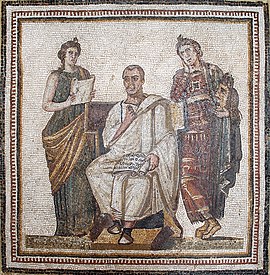
Tunisian culture is a product of more than three thousand years of history and an important multi-ethnic influx. Ancient Tunisia was a major civilization crossing through history; different cultures, civilizations and multiple successive dynasties contributed to the culture of the country over centuries with varying degrees of influence. Among these cultures were the Carthaginian – their native civilization, Roman, Vandal, Jewish, Christian, Arab, Islamic, Turkish, and French, in addition to native Amazigh. This unique mixture of cultures made Tunisia, with its strategic geographical location in the Mediterranean, the core of several civilizations of Mare Nostrum.

Sousse or Soussa is a city in Tunisia, capital of the Sousse Governorate. Located 140 km (87 mi) south of the capital Tunis, the city has 271,428 inhabitants (2014). Sousse is in the central-east of the country, on the Gulf of Hammamet, which is a part of the Mediterranean Sea. Its economy is based on transport equipment, processed food, olive oil, textiles, and tourism. It is home to the Université de Sousse.
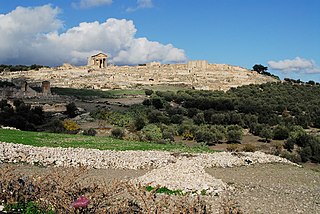
Dougga or Thugga or TBGG was a Berber, Punic and Roman settlement near present-day Téboursouk in northern Tunisia. The current archaeological site covers 65 hectares. UNESCO qualified Dougga as a World Heritage Site in 1997, believing that it represents "the best-preserved Roman small town in North Africa". The site, which lies in the middle of the countryside, has been protected from the encroachment of modern urbanization, in contrast, for example, to Carthage, which has been pillaged and rebuilt on numerous occasions. Dougga's size, its well-preserved monuments and its rich Numidian-Berber, Punic, ancient Roman, and Byzantine history make it exceptional. Amongst the most famous monuments at the site are a Libyco-Punic Mausoleum, the Capitol, the Roman theatre, and the temples of Saturn and of Juno Caelestis.

Thuburbo Majus is a large Roman site in northern Tunisia. It is located roughly 60 km southwest of Carthage on a major African thoroughfare. This thoroughfare connects Carthage to the Sahara. Other towns along the way included Sbiba, Sufes, Sbeitla, and Sufetula. Parts of the old Roman road are in ruins, but others do remain.

The Bardo National Museum is a museum of Tunis, Tunisia, located in the suburbs of Le Bardo.
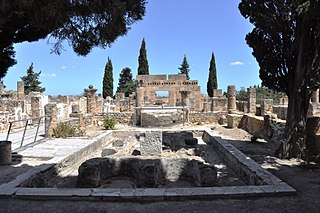
The House of the Cascade is a Roman-era building located in Utica, Tunisia. It is typical of most of the Roman houses excavated to date in North Africa in that it looks inwards to a central courtyard around which the majority of the rooms are arranged. Two smaller courtyard gardens in the western part of the house provided additional light and air.

Carthage National Museum is a national museum in Byrsa, Tunisia. Along with the Bardo National Museum, it is one of the two main local archaeological museums in the region. The edifice sits atop Byrsa Hill, in the heart of the city of Carthage. Founded in 1875 as the "Musée Saint-Louis" within the Chapelle Saint-Louis de Carthage in order to house the finds from the excavations of Alfred Louis Delattre, it contains many archaeological items from the Punic era and other periods.

Pupput, also spelled "Putput", "Pudput", "Pulpud" and "Pulpite" in Latin, sometimes located in Souk el-Obiod ou Souk el-Abiod, is a Colonia in the Roman province of Africa which has been equated with an archaeological site in modern Tunisia. It is situated on the coast near the town of Hammamet, between the two wadis of Temad to the north and Moussa to the south. Much of the Pupput is buried under modern holiday developments which have been built over the major part of the site.
Zeineb Benzina, whose full name is Zeïneb Benzina Ben Abdallah, born in Tunis, Tunisia, is an archeologist, and director of research at the Institut national du patrimoine based in Tunis.

M'hamed Hassine Fantar is a professor of Ancient History of Archeology and History of Religion at Tunis University.
Noël Duval was a French archaeologist.

The Ksour Essef cuirass is an ancient triple-disc cuirass found in a Punic tomb in 1909 not far from Ksour Essef, Tunisia.

The Altar of the Gens Augusta is a Roman altar associated with the Imperial cult of ancient Rome, which was discovered on the slopes of Byrsa hill above the port of the ancient city of Carthage. It is now kept in the Bardo National Museum in Tunis.
Aïcha Ben Abed is an archaeologist and Director of Monuments and Sites at the Institut National du Patrimoine, Tunisia. She is one of the world's leading authorities on the mosaics of Roman Africa.
Mohamed El Aziz Ben Achour is a Tunisian politician and historian born on 5 January 1951; he specializes in urban, social and cultural history of modern Tunisia and the Islamic civilization. He was the Minister of Culture some time between 2004 and 2008, and later Director-General of the Arab League Educational, Cultural and Scientific Organization (ALECSO) some time between 2009 and 2013.

The National Museum of Utica is a museum dedicated to archeology in Tunisia located in Utica. The museum is dedicated to preserving important historical objects from the history of North African civilizations.
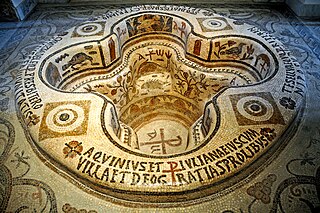
The Church of the Priest Felix and the Baptistery of Kélibia, or the Baptistery of the Priest Felix of Demna, are a building and an Early Christian baptismal font richly decorated with mosaics, discovered in the 1950s at Demna, in the Hammam Ghezèze delegation in Tunisia.
The Makthar Museum is a small Tunisian museum, inaugurated in 1967, located on the Makthar archaeological site, the ancient Mactaris. Initially a simple site museum using a building constructed to serve as a café on the site of a marabout, it comprises three rooms, some of which are displayed outside in a lapidary garden. Additionally, just behind the museum are the remains of a basilica.
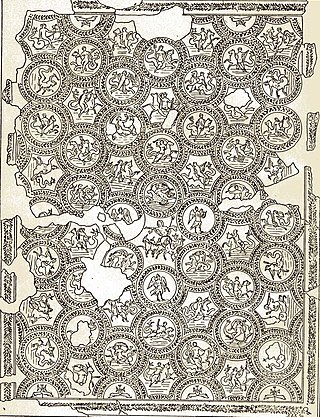
The Neptune Triumph and the House of Sorothus mosaic, also known as the Neptune and Nereids mosaic or the Neptune Procession mosaic, is a Roman mosaic dating from the 1st or 2nd century, discovered in Tunisia at the end of the 19th century, in the House of Sorothus on the site of Sousse, the ancient Hadrumetus.
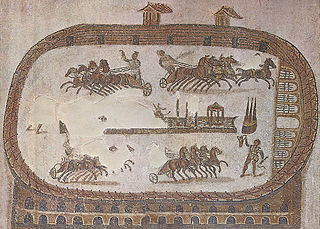
The Carthage Circus Mosaic is a Roman mosaic dating from the 1st or 2nd century, discovered on the archaeological site of Carthage, in present-day Tunisia, in the first quarter of the 20th century.
